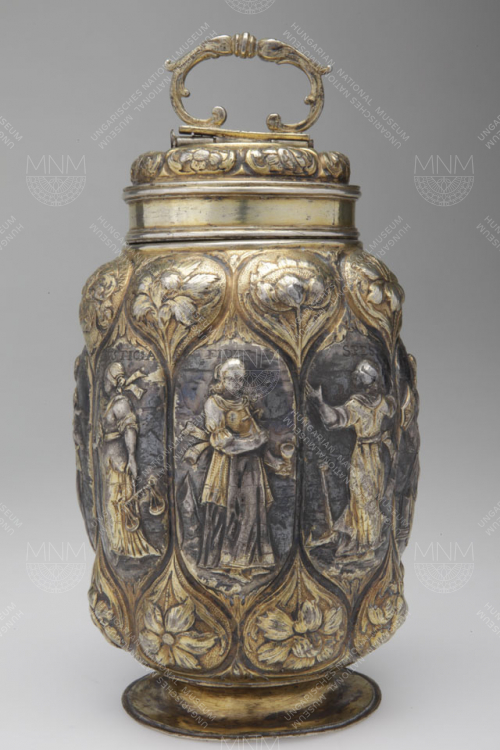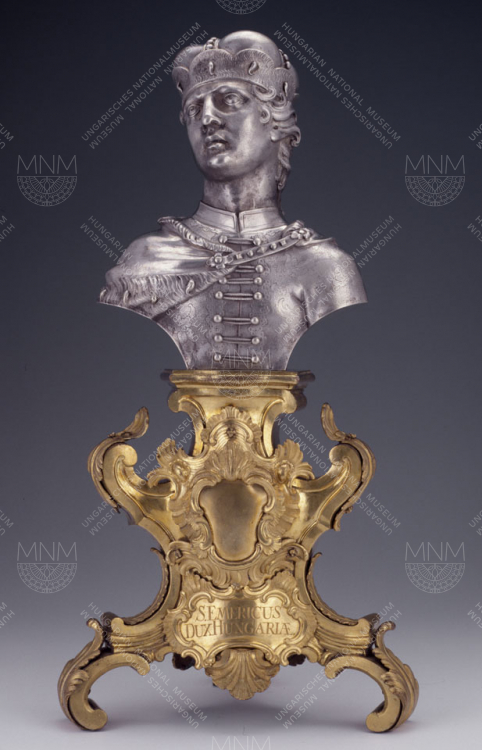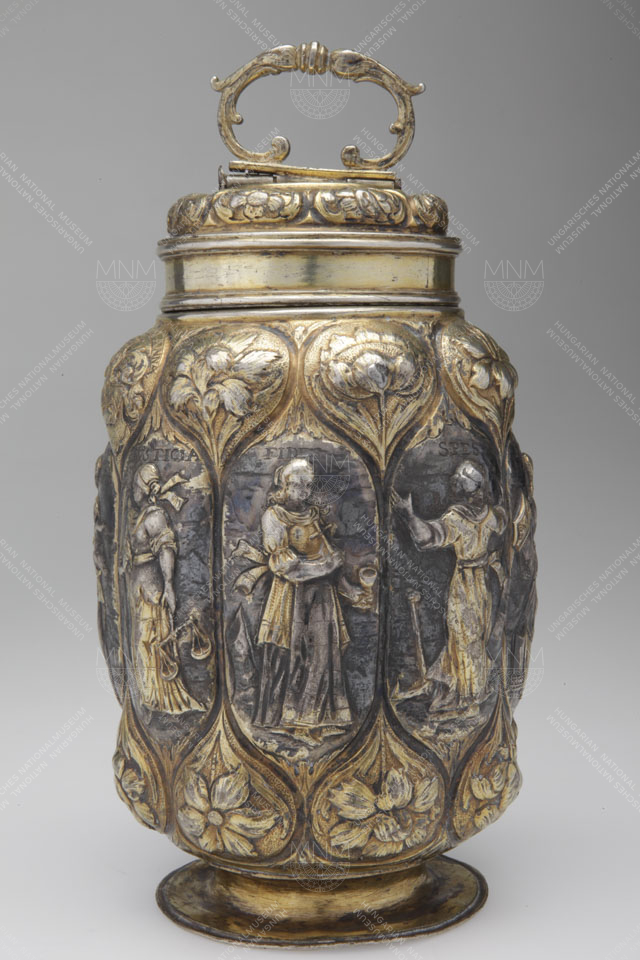
The Historical repository
The Historical repository short description
 3
3
Bottle
master mark: Sh (Sebestyén Hann?), probably in Sibiu
last third of the 17th century,
gold-plated silver, hammered, embossed, chiselled, punched, engraved
height: 19.7 cm, diameter at the bottom: 9 cm
Bottles were part of the early modern aristocratic world. Alcoholic beverages – mainly brandy and wine – were stored in them. used for the storage of. However, in Protestant regions they were often used during the Holy Communions. This South-Transylvanian bottle, decorated with allegorical figures of Christian virtues, came to the Protestant congregation of Székelykeresztúr in the 18th century. After the First World War, the congregation was forced to sell the goldsmith's work, which came to the collection of the National Museum at the end of the 20th century.

St. Imre's reliquary
Joseph Moser's woskhop, Vienna, cca 1760. Its base is likely to be made in Vienna, end of 19th century
silver, cast, engraved, punched, chiselled; the pedestal is gilded bronze
height: 43 cm
Maria Theresa ordered a series of reliquaries for the Imperial Church Treasury starting from the 1750's. Among them were relics of the saints of the Arpads. The relics of King St Stephen, Ladislaus and Imre were placed in the bases of the peson-like cast silver busts. The works were made by one of the most outstanding Viennese master of the era, Joseph Moser from Brno. several of the emperor treasures were removed from the 19th century. St. Imre's silver bust been lurking since the middle of the 20th century. Eventually the Hungarian National Museum bought it from art traders in Vienna in 2002.

Kettle
master mark: KO
silver, hammered, pressed, chiselled
height: 49 cm, diameter at the bottom: 19 cm
Having a tea is was considered an important social event starting from the 18th century. The ingredients for making a drink therefore did not only have practical but also representative functions as well. The large canister for boiling tea water was placed on a big-sized stand with a spirit-lamp. The tea was infused in a separate can. The decoration on this masterpiece of the Viennese artist is a decoration typical of the German version of Art Nouveau.
Bottle
master mark: Sh (Sebestyén Hann?), probably in Sibiu
last third of the 17th century,
gold-plated silver, hammered, embossed, chiselled, punched, engraved
height: 19.7 cm, diameter at the bottom: 9 cm
Bottles were part of the early modern aristocratic world. Alcoholic beverages – mainly brandy and wine – were stored in them. used for the storage of. However, in Protestant regions they were often used during the Holy Communions. This South-Transylvanian bottle, decorated with allegorical figures of Christian virtues, came to the Protestant congregation of Székelykeresztúr in the 18th century. After the First World War, the congregation was forced to sell the goldsmith's work, which came to the collection of the National Museum at the end of the 20th century.

St. Imre's reliquary
Joseph Moser's woskhop, Vienna, cca 1760. Its base is likely to be made in Vienna, end of 19th century
silver, cast, engraved, punched, chiselled; the pedestal is gilded bronze
height: 43 cm
Maria Theresa ordered a series of reliquaries for the Imperial Church Treasury starting from the 1750's. Among them were relics of the saints of the Arpads. The relics of King St Stephen, Ladislaus and Imre were placed in the bases of the peson-like cast silver busts. The works were made by one of the most outstanding Viennese master of the era, Joseph Moser from Brno. several of the emperor treasures were removed from the 19th century. St. Imre's silver bust been lurking since the middle of the 20th century. Eventually the Hungarian National Museum bought it from art traders in Vienna in 2002.

Kettle
master mark: KO
silver, hammered, pressed, chiselled
height: 49 cm, diameter at the bottom: 19 cm
Having a tea is was considered an important social event starting from the 18th century. The ingredients for making a drink therefore did not only have practical but also representative functions as well. The large canister for boiling tea water was placed on a big-sized stand with a spirit-lamp. The tea was infused in a separate can. The decoration on this masterpiece of the Viennese artist is a decoration typical of the German version of Art Nouveau.









